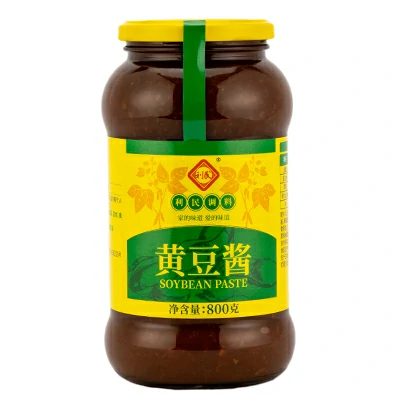Pasta di fagioli gialli fermentati, noto anche come Pasta di fagioli fermentati cinesi O pasta di fagioli larghi fermentati, è un ingrediente base nella cucina cinese. Questo condimento salato aggiunge profondità e umami a una varietà di piatti, rendendolo uno dei preferiti tra chef e cuochi di casa allo stesso modo. Ma cos'è esattamente, E come puoi usarlo in cucina? Esploriamo le sue origini, usi, e alcuni suggerimenti per incorporarlo nei tuoi pasti.
Ciò che è pasta di fagioli gialli fermentati?
Pasta di fagioli gialli fermentati è realizzato in soia o fagioli larghi che sono stati fermentati e conditi con sale. Il processo di fermentazione dà alla pasta la sua firma salata, salato, e un sapore leggermente dolce, Insieme a un ricco, aroma terroso.
Mentre ci sono variazioni regionali, L'ingrediente centrale rimane coerente, Fornire una base di sapore che migliora i piatti senza sopraffarli.
In che modo è diverso dalle altre paste cinesi?
- Pasta Di Fagioli Gialli Fermentati: Made principalmente di soia, Spesso più liscio nella consistenza, e leggermente più mite di sapore.
- Pasta Di Fave Fermentate: Usa fagioli larghi (fagioli fava) invece di semi di soia, Offrendo un forte, Gusto. Popolare nella cucina del Sichuan.
- Pasta di fagioli fermentati cinesi: Un termine generale che può riferirsi a una varietà di paste fermentate, comprese le opzioni simili a miso o più spesse, versioni più chunkier.

Usi popolari della pasta di fagioli gialli fermentati
1. Aromatizzare le fritte
- Aggiungi un cucchiaio a salti di verdure o di carne per elevare il loro profilo aromatico.
- Si abbina eccezionalmente bene a piatti come melanzane, fagioli verdi, o tofu.
2. Come base per le salse
- Mescolare con l'aglio, zenzero, e salsa di soia per un ricco, Salsa ricca di umami.
- Ideale per piatti di noodle o salse di immersione.
3. Migliorare i piatti brasati
- Usalo in stufati e brani per un ulteriore livello di complessità.
- Funziona magnificamente in piatti come pancetta di maiale brasata o pesce brasato.
4. Nelle marinate
- Combina con le spezie, zucchero, e olio per una marinata robusta.
- Particolarmente buono per grigliare o arrostire le carni.
5. Preparare piatti piccanti Sichuan
- La variante di pasta di fagioli larghi fermentata è un ingrediente chiave in piatti come Mapo Tofu e Dan Dan Noodles.
Suggerimenti per cucinare con pasta di fagioli gialli fermentati
- Inizia in piccolo: Il suo sapore forte significa che un po 'fa molta strada. Inizia con un cucchiaino e adattati a gusto.
- Equilibrare i sapori: Combinalo con elementi dolci o acidi (Come lo zucchero o l'aceto) per bilanciare la sua salsedine.
- Immagazzinare correttamente: Tienilo in un contenitore ermetico in frigorifero per mantenere la sua freschezza e sapore.
Perché dovresti provarlo
La pasta di fagioli gialli fermentata non è solo un condimento; È un gateway per l'autentica cucina cinese. Whether you’re recreating a classic recipe or experimenting with fusion dishes, Il suo ricco sapore umami migliorerà senza dubbio la tua cucina. Con pasta di fagioli fermentati cinesi o pasta di fagioli larghi fermentati, Puoi portare un tocco di tradizione culinaria cinese nella tua cucina.

